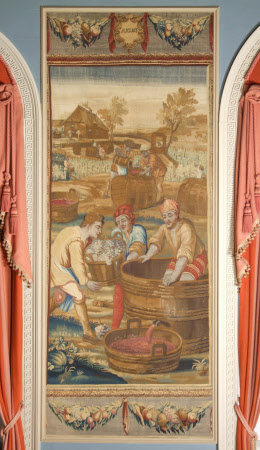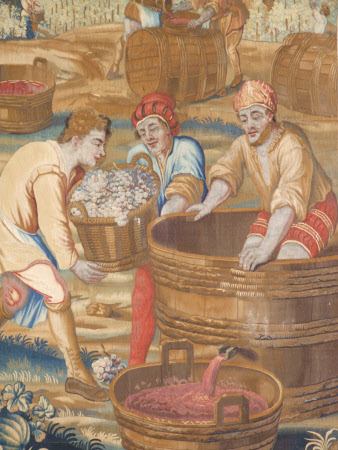August
probably Mortlake Tapestry Manufactory
Category
Tapestries
Date
circa 1660 - circa 1680
Materials
Tapestry, wool and silk, 6 warps per cm
Measurements
3.66 m (H); 1.445 m (W)
Place of origin
London
Order this imageCollection
Clandon Park, Surrey
NT 1441619.3
Summary
[Destroyed in the fire of 2015] Tapestry, wool and silk, 6 warps per cm, August from a set of five Months, English, probably Mortlake, c. 1660-1680. In the right foreground a man stands in a large wooden tub trampling grapes, their juice flowing from a tap at the bottom of the barrel into a basin on the ground nearby. Two more men arrive from the left carrying a large basket of grapes to add to the tub. In the background juice is being poured into barrels, and beyond there is a vineyard and a wooden house. There are borders at the top and bottom with swags of fruit and leaves tied with red ribbons on a light blue ground, and at the upper centre there is a cartouche inscribed with the word ‘AUGUST’. At the sides all that remains are the inner edges of wider borders.
Full description
The five tapestries of the 'Months' at Clandon are part of a larger series representing the twelve months of the year according to the typical countryside activities of each. Representations of the labours of the months have their origin in early Christian calendars where they were associated with the signs of the zodiac and signified the passing of celestial and terrestrial time until the Second Coming and the Last Judgement (Webster, 1938). The iconography of the months, focussing on the agricultural activities associated with them, was developed in the illustrations to medieval books of hours. During the fourteenth century these scenes were often expanded into representations of daily life, the best-known example the 'Très-Riches Heures' begun in 1411-13 by the Limbourg brothers for Jean, Duc de Berry. Although the iconography was never fixed certain activities came to be associated with each month, for example haymaking in July, hawking in May and pig-killing in December, all seen in the Clandon set. The subject of the labours of the months was very popular in tapestry design from the early sixteenth century. A number of important series were designed between c. 1520 and 1540, including the so-called 'Medallion Months', the 'Months of Lucas', that were in the French Royal Collection and were repeatedly copied during the seventeenth and eighteenth centuries, and the famous 'Hunts of Maximilian', which were also copied at the Gobelins and elsewhere in the seventeenth and eighteenth centuries (there is a Flemish seventeenth-century variant in the National Trust's collection at Upton House, no. 446875). The Clandon tapestry designs are based on a now lost early sixteenth-century series that was copied at Mortlake in the early seventeenth century, possibly from a set in the collection of Henry VIII, and woven for Charles I in the early 1620s. A complete set of six (each tapestry including two months) made at Mortlake for Dr. John Williams, Bishop of London in the early 1620s is in the collection of the City of Genoa (Hefford 2006) and a partial set with the arms of Charles as Prince of Wales is in the Royal Collection with three panels on display at Kensington Palace. The designs, sometimes referred to as the 'Seasons' as well as the 'Months', became one of the staples of the Mortlake workshop, and continued to be woven after the Restoration of 1660. The Clandon tapestries belong to this later period. The activities in the original Mortlake series of 'Months' (and the now-lost sixteenth-century series it was based on) are as follows: January – a meal by the fire-side February – grafting fruit trees March – pruning vines and digging a vegetable garden April – milking May – falconry June – sheep-shearing July – haymaking August – the harvest September – sowing seeds October – the vintage November – threshing December – pig-killing The scenes that survive at Clandon are as follows: April – milking May – falconry June – sheep-shearing July – haymaking (June and July combined in one scene) August – the vintage (the scene originally used for October) December – pig killing The designs at Clandon follow those of the original Mortlake series with some modifications, indicating that at some point the cartoons have been redrawn. The scene of the vintage has been transferred from the month of October to August. The borders at Clandon are also a simplified version of those used on the Mortlake weavings on the 1620s and ‘30s. They are composed of swags of fruit and leaves with putti on a light blue ground with roundels containing gods and goddesses at the corners, roundels with Caesars’ heads at the centre of each side, and small cartouches inscribed with the name of each month at the top. The tapestries at Clandon were woven either at Mortlake or by the Yeoman Arrasworker Francis Poyntz, between c. 1660 and 1680. It is known that both workshops were producing sets of ‘Months’ in this period. In the 1670s a set woven with gold thread was made for the Queen's Bedchamber at Ham House by Poyntz, who also supplied sets of 'Months' with gold thread to Charles II (see Wyld 2013 a). Another set of ‘Months’ after modified versions of the designs seen at Clandon is in the National Trust’s collection at Ham House (nos. 1140555, 1140105). This set was probably woven by Stephen de May, an ex-Mortlake weaver who set up his own workshop at the end of the seventeenth century. There is also a single tapestry of ‘May’, again probably English, in storage at Lanhydrock (no. 885701). Although they fit exactly into the spaces between windows in the Saloon at Clandon, there is clear evidence that the ‘Months’ have been significantly altered to fill these spaces. ‘April’ and May’ originally formed a single piece and have been separated; ‘August’ and December’ appear to have had their borders removed and may have been made narrower, and the side borders on ‘June and July’ come from an unrelated tapestry. (Helen Wyld, 2013)
Provenance
Purchased by the Ministry of Public Building and Works in 1963 from the 6th Earl, transferred to the National Trust in 1977
Marks and inscriptions
In cartouche at centre of upper border: AUGUST
Makers and roles
probably Mortlake Tapestry Manufactory , workshop possibly Francis Poyntz (fl. 1660 - d. 1684), workshop
References
Wyld, 2013 a: Helen Wyld, 'Seventeenth-century Tapestries at Ham House', in Christopher Rowell (ed.), Ham House: 400 Years of Collecting and Patronage, New Haven and London 2013, pp. 178-93 Hefford, 2006: Wendy Hefford, 'I Mesi di Mortlake, un serie di arazzi inglesi a Genova', in P Boccardo and C Di Fabio (eds.), Genova e l'Europa atlantica: opere, artisti, committenti, collezionisti, Milan 2006, pp. 167-181 Webster, 1938: J. C. Webster, The Labours of the Months in Antique and Medieval Art to the End of the Twelfth Century, Princeton 1938

